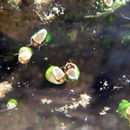Comprehensive Description
provided by Smithsonian Contributions to Zoology
Pyrgulopsis avernalis (Pilsbry, 1935)
Fluminicola avernalis Pilsbry, 1935a:92, fig. 1.—Morrison, 1940:124.—Gregg, 1941:117.—Baker, 1964:171.—Taylor, 1965:599.—USDI, 1991b:58819.
“Fluminicola” avernalis.—Taylor, 1975:40; 1983:294.
DIAGNOSIS.—Shell globose-trochoid, medium-sized, umbilicus small-absent. Penial filament very short and narrow, lobe absent. Penial ornament a large, superficial ventral gland.
DESCRIPTION.—Shell (Figure 8g) globose-trochoid; height, 2.4–4.3 mm; whorls, 4. Protoconch (Figure 1a) very weakly punctate. Teleoconch whorls slightly convex, often shouldered; sutures very shallow; sculpture of strong growth lines. Aperture large, lunate, adnate to body whorl. Inner lip complete, highly thickened; columellar lip often strongly reflected. Outer lip often thick, strongly sinuate in larger specimens, with pronouced adapical notch. Umbilicus absent to small. Periostracum light brown.
Operculum (Figure 8h,i) ovate, light amber; nucleus slightly eccentric; dorsal surface smooth. Attachment scar margin thickened thickened almost all around, broadly so between nucleus and inner edge; callus moderate.
Central radular tooth (Figure 32e) with highly indented dorsal edge; lateral cusps, 4–5; central cusp pointed, slightly broader and longer than laterals; basal cusps, 1, short, with weak dorsal support. Basal process narrow; basal sockets deep. Lateral margins slightly thickened; neck pronounced.
Dark internal pigment patch prominent just posterior to base of cephalic tentacle. Cephalic tentacles, snout, foot, opercular lobe, neck otherwise pale or light brown. Pallial roof with prominent dark internal pigment patch on right edge near mantle collar, roof otherwise pale to moderate brown. Gonad brown-black; visceral coil otherwise pale to moderately dark brown.
Ctenidial filaments, 25, tall, broad. Osphradium centered posterior to middle of ctenidial axis. Kidney opening slightly thickened. Stomach caecum a small, narrow flap.
Testis, 1 whorl, overlapping posterior stomach. Prostate gland bean-shaped, broadened posteriorly; pallial section large (33%). Vas deferens opening from near anterior end of prostate gland, pallial section gently undulating. Penis (Figure 43e) large, extending well beyond mantle edge; base elongate rectangular, filament very short, extremely narrow, well tapered, with pointed tip; lobe absent. Ventral gland very large, circular, pad-like, borne along left edge near distal tip. Filament pale, base lightly pigmented along right edge.
Female genitalia shown in Figure 4c. Ovary, 0.75 whorl, overlapping posterior stomach. Pallial oviduct small, terminating well posterior to mantle edge. Albumen gland without pallial section. Capsule gland about equal to albumen gland in length, highly thickened. Genital aperture a long terminal slit; vestibule well developed. Coiled oviduct a short horizontal twist broadly overlapping a broader horizontal loop. Oviduct and bursal duct anterior to oviduct coil just behind pallial wall. Bursa copulatrix ovoid, slightly oblique, elongate (85%), medium width, positioned near ventral edge of albumen gland, with 30%–40% of length posterior to albumen gland. Bursal duct medium width, slightly shorter than bursa copulatrix, sometimes emerging slightly lateral to anterior tip of bursa copulatrix, partly embedded in albumen gland. Seminal receptacle narrow, folded, short, positioned lateral to anterior bursa copulatrix near ventral edge of albumen gland.
TYPE LOCALITY.—Types are fossil (Late Cenozoic) shells, with type locality given as Colorado Desert. This appears to be an error as there are no other reliable records of similar-shelled hydrobiids from this region. The species was attributed to Pahranagat Valley, Nevada by Morrison (1940) on the basis of its association with Tryonia clathrata, but there is no known material of avernalis from that valley. Gregg (1941) reported live material from Moapa Valley, Nevada (south of Pahranagat Valley), which probably is the type locality area given that this species appears to be endemic to the valley (also see Pratt, 1977). Lectotype (Baker, 1964:171), ANSP 27784; paralectotypes, ANSP 375737, a mixed lot containing several specimens of P. carinifera.
DISTRIBUTION.—Springs in Moapa Valley, southern Nevada, Colorado River drainage.
MATERIAL EXAMINED.—USNM 874000, USNM 874003, Oasis Spring, Moapa Valley, Clark County, Nevada (T 14S, R 65E, sec. 16).
- bibliographic citation
- Hershler, Robert. 1994. "A review of the North American freshwater snail genus Pyrgulopsis (Hydrobiidae)." Smithsonian Contributions to Zoology. 1-115. https://doi.org/10.5479/si.00810282.554
Pyrgulopsis avernalis: Brief Summary
provided by wikipedia EN
The Moapa pebblesnail also known as the Muddy Valley turban snail, scientific name Pyrgulopsis avernalis, is a species of small freshwater snail with an operculum, an aquatic gastropod mollusk in the family Hydrobiidae.
The natural habitat of this species is springs, and it is currently threatened by habitat loss. This species is endemic to the Moapa Valley, Nevada, United States and the common name refers to the Moapa River in Nevada.
- license
- cc-by-sa-3.0
- copyright
- Wikipedia authors and editors

